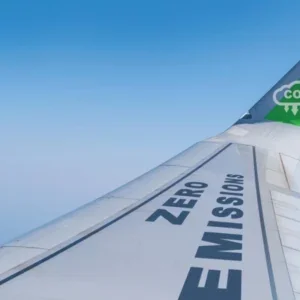The inauguration of the new Istanbul Airport took place on 29 October, the country’s ‘Republic Day’, after a construction project that took 42 months to complete the largest single-roof airport in the world. With ground broken in May 2015, the site covers 41km2, but this will increase to 76km2 over coming years, making the aviation mega-hub bigger than the whole of Manhattan Island (59km2). At the ribbon cutting, President Erdogan reportedly said that his country will become the “most important transit location on the northsouth, east-west axes, connecting 60 countries and $20-trillion economies”.
Although the intention was for full-scale operations to begin in the autumn, delays have meant that only a limited number of services will run until all airlines have been moved over from the existing Ataturk Airport by the end of the year. (Initial routes will be with Turkish Airlines to Cyprus and Baku, and Ankara, Antalya and Izmir within Turkey.) As well as being the flag carrier’s new base, the airport will accommodate more than 100 other airlines, which will have use of 114 gates and a 42km-long luggage system. Overall, the airport will be able to process 3,500 take-offs and landings a day. Displaying enviable levels of security, it also features 9,000 CCTV cameras with facial recognition technology built in.
Bigger, better, busier
With a price tag of $11 billion ($7.2 billion for phase one), it is no wonder this ambitious private-public partnership wants to be better than all the rest. Over the months leading up to the airport’s debut, trials involving up to 5,000 passengers, 1,000 staff and 10,000 pieces of fake luggage took place to make sure it could cope in real-world situations. Post-unveiling, hundreds of trucks are to be sequestered to transport equipment – and aircraft – from Ataturk as part of a mass migration of services. CEO of airport operation for IGA, Kadri Samsunlu, said in a statement that the transfer to the new Istanbul Airport would be the “biggest ever in the world”.
Located near the Black Sea, in the Arnavutköy district, 40 minutes’ drive north of Istanbul’s city centre on the European side (a new metro line will be installed by 2020), the airport is set to become a gateway to 350 destinations, and will be big enough to serve 90 million passengers a year during its first phase. Once all four phases have been completed in 2028, this will increase to 200 million. (In 2018, the world’s busiest airport was Atlanta Hartsfield-Jackson International, with just over 100 million passengers a year.) While Ataturk will close, Sabiha Gokcen – on the Asian side of Istanbul – will continue operations.
To get things started, the new airport has two parallel runways measuring 3,750 and 4,100m long, and a torch-like ATC tower, inspired by the flowing forms of the country’s national flower, the tulip. It was designed by Italian design house Pininfarina and US engineering company AECOM, after they won the bid to work on it in 2016. Phases two and three are scheduled for 2021 and 2022, when two more ATC towers and another two runways will be added. Phase four will see the addition of the fifth and sixth runways, plus a new satellite terminal – making three terminals in all. In total, the airport will be able to accommodate 500 aircraft at any one time, and the surrounding grounds will host parks, mosques, conference centres and hotels.
When looked at from above, the 1.4km2 terminal building is shaped like a capital ‘H’ pinched in the middle, with aircraft piers providing the stems. At the heart is an enormous central hall, with two and a half levels for arrivals and departures. Inside, there are 228 passport desks, and the planet’s biggest duty-free retail complex, covering 5.5km2. Also opening will be the only in-airport hotel, Yotel. The capsule concept will have 451 cabins (349 of which will be landside and 102 airside, after security), plus a 24-hour gym, restaurant, bar, co-working space and meeting rooms.
Master planners
Leading the concept design of the airport was global architectural firm Grimshaw, alongside Nordic — Office of Architecture from Norway and London studio Haptic Architects. Together, the team was responsible for the concept design of Terminal One, as well as initial designs for the forthcoming Terminal Two and an airside satellite concourse. The design of Terminal One was developed by international architectural practice Scott Brownrigg, which was also responsible for the interior design concept, and worked with local architectural delivery teams including Fonksiyon Mimarlik, Turgut Alton Mimarlik, and Kiklop Design and Engineering to deliver the project.
Andrew Thomas, a partner at Grimshaw, describes what is unique about the new Istanbul Airport development. “In terms of its scale, it is absolutely unprecedented,” he says. “[But] while it’s grand, we have really sought to design it to a human scale, with intuitive wayfinding and a rich variety of experiences that will make it an enjoyable place for people to use and spend time in.”
Unlike older, past-their-prime airports that are architecturally and aesthetically bland and dated, Istanbul Airport sports majestic vaulted ceilings through which daylight is filtered via dozens of skylights. Long, smooth moving walkways take people past floor-toceiling glass windows, and for those looking for a breather, there is a beautiful open-air forecourt with greenery and al fresco seating under wing-like canopies. Thomas explains how the architects harnessed light to improve well-being. “Sunlight within a terminal building provides a connection to the outside world and brings the internal spaces to life throughout the day. The slatted ceiling surface provides control of direct sunlight to avoid glare, while casting rich patterns of light inside the terminal.”
In terms of inspiration for the overall design concept, Tomas Stokke, director at Haptic Architects, says the team looked to the city and its variety of Ottoman monuments. “The new airport is conceived as a grand gateway to Turkey that is absolutely and unmistakably of its time and place,” he says. “Istanbul is a vibrant and youthful city, with the most wonderful architectural tradition expressed in its spectacular historic buildings, most notably the great work of the classical Turkish architect, Mimar Sinan [who designed the Suleiman Mosque, among other things, in the 1500s]. These techniques of light, pattern, texture and colour [found in the new airport] are deeply influenced by the traditional art and architecture of Turkey.”
Rewrite the rules of what airports should be
In terms of what have been some of the biggest challenges the architects faced in designing the terminal, Ingrid Motzfeldt, partner at Nordic — Office of Architecture, explains, “We could see that at this scale, and with this amount of people, the established ‘rules’ of airport design needed to be replaced with new modes of thinking. We had to constantly test and re-evaluate what would work for a ‘normal’ airport to see if it was at all applicable at this scale.”
Thomas agrees, “It was critical that we developed design proposals that were simple and modular to build in order to support rapid construction. The steel structure and the roof are very simple and quick to build, while the architectural quality is primarily achieved through the form and rhythm of the vaulted ceilings and the quality of natural light. Another concern was how we could create a terminal to serve such a huge volume of passengers that would allow all of those people to navigate simply, within acceptable walking distances and with minimal level changes.”
Grimshaw has a long history of working on other airports, like Pulkovo in St Petersburg, London Heathrow and Zurich. Comparisons aren’t easy but there are always common themes that are fundamental to Grimshaw’s ethos, which are certainly evident in Istanbul. “It can be seen as part of an evolution of certain key ideas and qualities that at Grimshaw, we always seek to embody in our projects: we want our terminals to be clear, well ordered and easily understood by the people that will use them,” Thomas says. “While they are big buildings, they should be designed with the experience of the individual user in mind, allowing for moments within the journey that offer respite and joy.”
He adds, “Plentiful natural light and warm materials are employed to create positive environments for people, and we treat the experience of arriving passengers to be of equal importance to that of those departing. The opportunity to spend time relaxing within a pleasant environment that offers a diverse range of concessions and other amenities can create a memorable experience and a positive start to a passenger’s journey. For the airport operator, the revenue provided by these facilities is, of course, a fundamental part of their business plan. Finally, we design using modular and loose-fit structures to accommodate the inevitable change that the building will face in its lifetime.”
While Istanbul may not have the hiking trails and waterfalls found in Singapore Changi’s forthcoming Jewel terminal, there is no doubt that Istanbul Airport is part of a growing trend for turning airports into aesthetically and spiritually uplifting public spaces that go beyond function. It is a place people will, hopefully, want to spend time in rather than rushing from the self-check-in kiosk to the gate as quickly as possible. “This terminal is definitely the dawn of a new era in terms of passenger experience,” says Maurice Rosario, aviation director at Scott Brownrigg. “With its clear sense of place and human scale despite its size, it is setting the blueprint for future megahub airports.”






